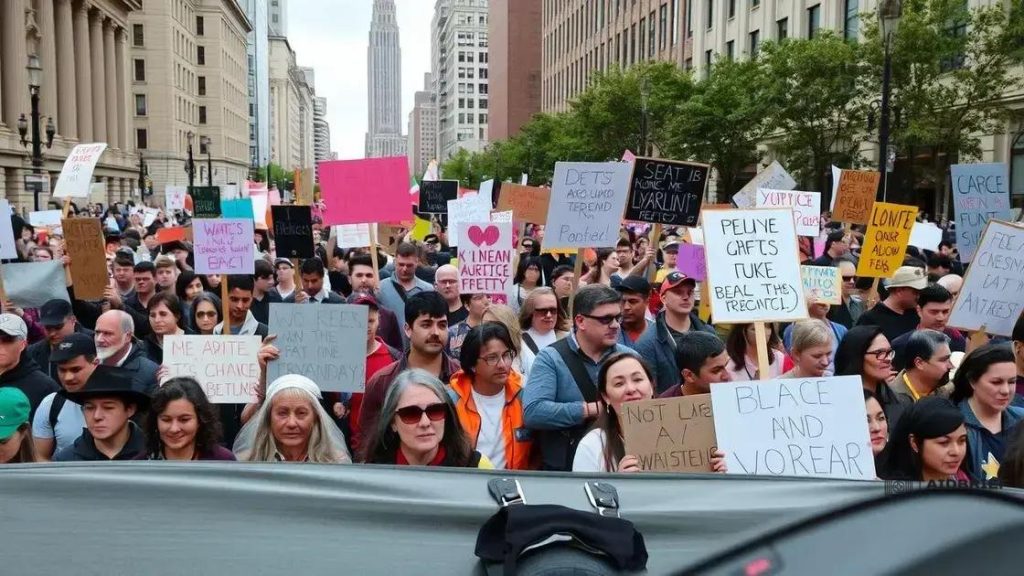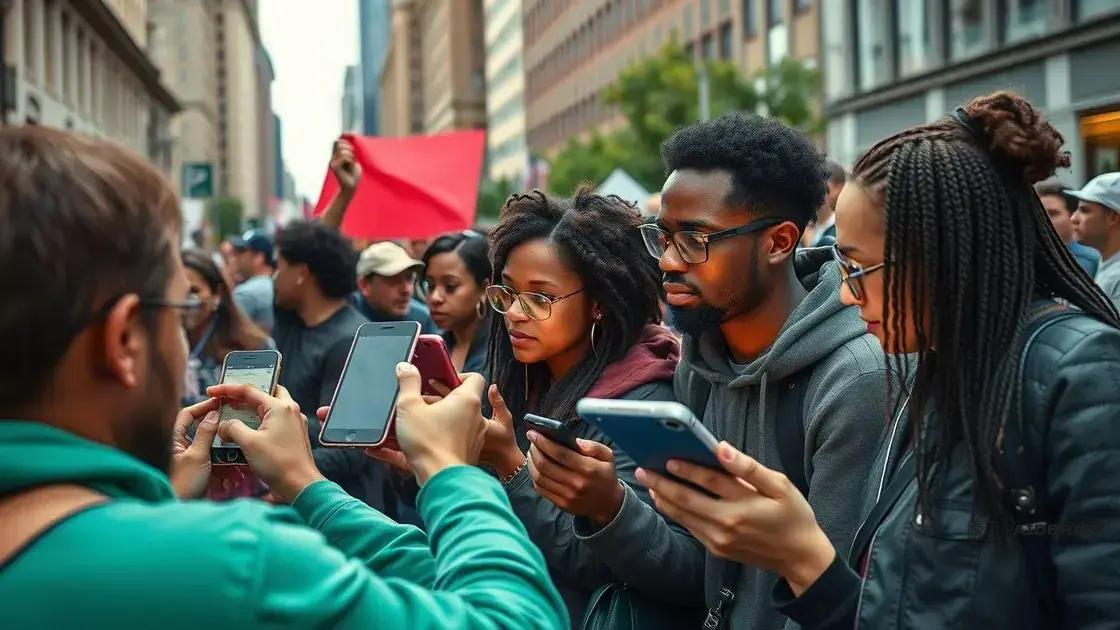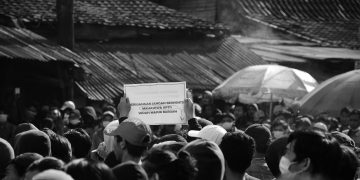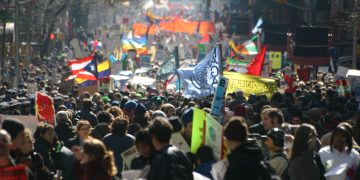Nationwide protest coverage: what you need to know

Nationwide protest coverage reflects the voices of communities advocating for social justice, often driven by specific grievances and amplified through social media, while navigating complex legal landscapes and local responses.
Nationwide protest coverage is more than just headlines; it shapes our understanding of societal issues. Have you ever wondered how these events influence public opinion and policy? Let’s dive into what’s happening out there.
Understanding the context of nationwide protests
Understanding the context of nationwide protests is essential for grasping their significance. These demonstrations often arise from deep-seated issues in society, reflecting public dissatisfaction and calls for change.
Protests can be fueled by various factors, including social injustice, economic concerns, and political decisions that impact communities. When we consider the backdrop of recent events, it becomes clear that emotions run high and that the stakes are often personal.
Key Factors Contributing to Protests
Several core issues consistently underline the reasons for nationwide protests:
- The fight for civil rights and equality.
- Discontent with government policies and their effects on daily life.
- Social media’s role in rapidly spreading awareness and mobilizing supporters.
As we explore these themes, it’s important to recognize the diverse voices participating in these movements. Each protester carries their own experiences and hopes, united by a common purpose. The visibility of these protests is amplified through online platforms, challenging mainstream narratives.
The Role of Historical Context
History plays a crucial role in understanding the present. Movements today are often built upon lessons learned from the past. Historical incidents of injustice resonate in the memories of communities, fueling ongoing activism. This deep historical context enhances the urgency of current protests, making them more than just fleeting moments in time.
Ultimately, reflecting on the context surrounding these protests invites us to consider how social change happens. It’s not just about the demonstrations themselves; it’s about the dialogues they start and the actions they inspire within society.
Key events that shaped the recent demonstrations
Several key events have significantly shaped the recent demonstrations across the country. Each event serves as a marker in the timeline of activism, reflecting the public’s response to various issues.
Understanding these pivotal moments helps to illustrate why protests gain momentum. In many cases, these events tap into widespread feelings of frustration and a desire for change.
Pivotal Incidents
Among the notable events that have sparked protests:
- The tragic death of a public figure under controversial circumstances, which ignited outrage.
- Government policies perceived as unjust, particularly those affecting marginalized communities.
- High-profile court rulings that seemed to dismiss public concerns over inequality.
- Grassroots movements gaining traction via social media campaigns.
These events resonate deeply within communities, often serving as a catalyst for collective action. The emotional weight of these incidents cannot be understated, as they invoke memories of past grievances and highlight ongoing struggles.
Media Coverage Impact
The role of media coverage has also been crucial in shaping public perception of protests. Coverage can either amplify voices or drown them out, depending on how narratives are framed. Social media has democratized the way information is shared, allowing firsthand accounts to circulate widely.
The portrayal of protests in media often affects public support, ultimately influencing the outcomes of these movements. Activists now harness both traditional and digital platforms to share their stories and mobilize supporters effectively.
As the landscape of activism continues to evolve, understanding key events and their implications becomes essential for engaging with ongoing discussions around social justice and community rights.
The impact of social media on protest coverage

The impact of social media on protest coverage cannot be overstated. Social media platforms serve as vital tools for mobilizing support and sharing information rapidly.
In today’s digital age, news travels fast. When protests occur, social media acts like a megaphone, amplifying messages and raising awareness.
Key Benefits of Social Media in Protests
Here are a few ways social media enhances protest coverage:
- Real-time updates: Activists can share live updates from the ground, keeping everyone informed instantly.
- Diverse voices: Social media allows people from various backgrounds to share their perspectives, enriching the narrative.
- Broader reach: Posts can go viral, reaching a global audience and garnering support from distant communities.
These benefits create an environment where public opinion can shift more quickly than ever. Traditional media often follow trends set by conversations happening online.
Challenges Faced
However, the use of social media is not without its challenges. Misinformation can spread just as rapidly, leading to confusion and misinterpretation of events. When hashtags or posts go viral for the wrong reasons, they can overshadow the core messages of the protests.
Moreover, algorithms can influence which voices are amplified and which are muted, making it hard for some messages to reach their intended audience. Despite these challenges, the role of social media in shaping public discourse around protests remains profound.
By providing a platform for organizers to connect and engage with supporters, social media has transformed the landscape of activism, influencing how protests are organized and perceived in mainstream media.
Voices from the ground: firsthand accounts
Understanding the voices from the ground is crucial to grasping the true essence of protests. Firsthand accounts from those involved provide valuable insights that statistics and reports often overlook.
Individual stories create a personal connection, illustrating the varied experiences of participants. These narratives shed light on why people choose to take to the streets and what they hope to achieve.
Personal Testimonies
Here are a few key elements often found in firsthand accounts:
- Emotional impact: Protesters often speak about the intense feelings they experience, from anger to hope.
- Specific incidents: Many share moments that motivated them to join the movement, often detailing events that resonate deeply.
- Community connection: Participants frequently mention the sense of unity and support felt among fellow protesters.
These accounts not only humanize the movement but also inspire others to join the cause. Social media plays a large role in amplifying these voices. Protesters share their stories widely, inviting others to participate in the dialogue.
Impact on Public Perception
Hearing directly from those on the ground can shift public perception significantly. When individuals share their experiences, it challenges stereotypes and encourages empathy. The stories of everyday people facing injustice resonate with a broader audience, making the causes more relatable.
Many documentaries and news segments now focus on these personal narratives, allowing viewers a glimpse into the lives of the activists. This shift towards storytelling enriches the discussion around protests, emphasizing the *human aspect* behind the movements.
As we listen to these voices, we better understand the motivations driving these protests and the hopes for a better future.
Legal implications and responses to protests
The legal implications and responses to protests are critical to understanding the dynamic between activists and authorities. Laws can either protect the rights of demonstrators or limit their ability to express dissent.
Different states have various laws regarding the right to assemble and protest. In some areas, protests are met with supportive legal frameworks, while in others, the laws are restrictive, leading to conflicts between law enforcement and protesters.
Understanding the Laws
Protesters should be aware of their rights. Here are some key legal aspects to consider:
- First Amendment rights: In the U.S., the First Amendment guarantees the right to free speech and assembly.
- Permits: Many jurisdictions require permits for large gatherings, which can impact how protests are organized.
- Law enforcement tactics: The regulations governing police responses can vary, affecting how protests are handled.
Knowing these legal frameworks helps protesters prepare for potential challenges. Crafting a successful protest often involves understanding these nuances to protect both themselves and their message.
Responses from Authorities
How authorities respond to protests can significantly impact public opinion and the effectiveness of the movement. Some governments may initiate dialogue with protesters, recognizing their demands and striving to address grievances. In other cases, heavy-handed tactics may lead to escalated tensions.
Community reactions to these methods vary. When authorities respect protesters’ rights, it can foster goodwill and potentially lead to positive changes. Conversely, aggressive responses may alienate the community and heighten divisions.
As protests continue to evolve, the legal landscape and responses from authorities will remain central to the discussions around activism. Understanding these interactions helps activists navigate challenges while striving for their goals.
FAQ – Questions about Nationwide Protest Coverage
What are the key reasons for recent nationwide protests?
Recent nationwide protests have been driven by issues like social injustice, government policies, and the need for systemic change.
How does social media influence protest movements?
Social media amplifies voices, enables real-time updates, and broadens the reach of protest messages, allowing for greater public awareness.
What legal rights do protesters have?
Protesters typically have the right to free speech and assembly under the First Amendment, but laws can vary by location.
How do firsthand accounts shape public perception of protests?
Personal stories from protesters help humanize movements, fostering empathy and understanding that statistics alone cannot provide.





